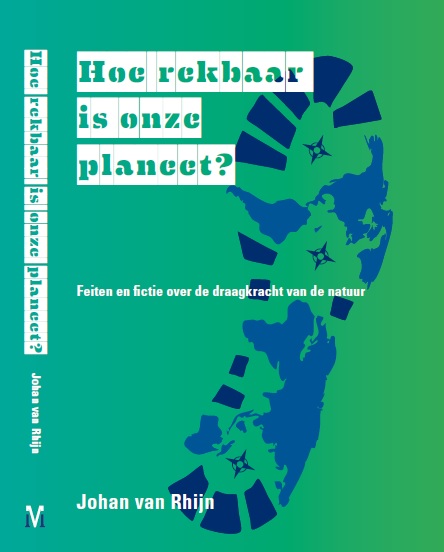the Environment and Political Power

This book (in Dutch) was published on 24 February 2023 bij Boekscout:
Title: 'Het Milieu en de Macht - waarom we niet voor morgen zorgen' (Environment and political power - why we do not care for tomorrow). So, I did not sit down during the corona period, or actually I did so.
Theme: Why our western democratic system is almost powerless for taking long term decisions on, for instance, biodiversity and climate, and how the system could function better. Thus, the book is on politics, but also on history, juridiction, economy and money.
One might think that I have strayed from my interest in biology and other sciences. Not really, the book emerges from the ecocrisis. I consider the climatecrisis as a component of that.
Reason: In 2022 there were eight billion people on earth. All together, they consumed about one and a half times the amount that can be produced by nature in that period. Biodiversity was greatly affected and the climate changed, resulting in higer temperatures and higher sea levels. Some of these processes can not or hardly be reversed. We survive by using (and depleting) the stocks on earth, and thus restrict possibilities for future generations. In 2010 I published a book on it: 'Hoe rekbaar is onze planeet?' (How extensible is our planet?).
Title: 'Het Milieu en de Macht - waarom we niet voor morgen zorgen' (Environment and political power - why we do not care for tomorrow). So, I did not sit down during the corona period, or actually I did so.
Theme: Why our western democratic system is almost powerless for taking long term decisions on, for instance, biodiversity and climate, and how the system could function better. Thus, the book is on politics, but also on history, juridiction, economy and money.
One might think that I have strayed from my interest in biology and other sciences. Not really, the book emerges from the ecocrisis. I consider the climatecrisis as a component of that.
Reason: In 2022 there were eight billion people on earth. All together, they consumed about one and a half times the amount that can be produced by nature in that period. Biodiversity was greatly affected and the climate changed, resulting in higer temperatures and higher sea levels. Some of these processes can not or hardly be reversed. We survive by using (and depleting) the stocks on earth, and thus restrict possibilities for future generations. In 2010 I published a book on it: 'Hoe rekbaar is onze planeet?' (How extensible is our planet?).

Story: One could expect that governments try to stop and reverse these processes, but politicians and leaders (of all political forces) fail to act adequately. Why? Because this could impair their re-election? Because it could lower the power of their political parties? This book is an attempt to find out why governments are so slow, by examining the power structures in human communities during our (pre)history up to now. It required a lot of reading and discussion about topics that were new to me as a biologist. In addition I made use of a eyewitness, my great-grandfather, who kept an extensive diary during about fifty years around the transition between the nineteenth and twentieth century. He made a lot of short notes, not only about events in his neighbourhood, but also in the country and the world. I conclude with suggestions about changes in the distribution of power that could facilitate the development and execution of long term policies.
Further details: The book is meant for 'the critical reader of newspapers': thus anyone who follows 'the news'. It provides an overview of our political history, the current political structures, and economy as a major driving factor. It is focused on The Netherlands, but also discusses the situation in many other western democratic countries. Much attention is payed to the policies that have been developed to protect environment, nature, biodiversity, and climate. The book refers to many sources, includes 21 chapters, an epilogue, annotations by mayor Adriaan Hoogendoorn of Midden-Groningen, a bibliography and an index. Please contact me ( johan-van-rhijn@wxs.nl ) for more information.
The book contains 224 pages and can be ordered at Boekscout , bol.com and every bookshop in The Netherlands and Belgium. As the book is printed on demand, delivery will take 3-5 working days.
ISBN: 9789464684964
Price: € 22,99
Further details: The book is meant for 'the critical reader of newspapers': thus anyone who follows 'the news'. It provides an overview of our political history, the current political structures, and economy as a major driving factor. It is focused on The Netherlands, but also discusses the situation in many other western democratic countries. Much attention is payed to the policies that have been developed to protect environment, nature, biodiversity, and climate. The book refers to many sources, includes 21 chapters, an epilogue, annotations by mayor Adriaan Hoogendoorn of Midden-Groningen, a bibliography and an index. Please contact me ( johan-van-rhijn@wxs.nl ) for more information.
The book contains 224 pages and can be ordered at Boekscout , bol.com and every bookshop in The Netherlands and Belgium. As the book is printed on demand, delivery will take 3-5 working days.
ISBN: 9789464684964
Price: € 22,99
Chapters
1 Uncertain Future
2 Postponed
3 Roots
4 Farming and Economy
5 Power
6 Revolution
7 Liberty, Equality and Fraternity
8 From Republtoic Monarchy
9 Power(lessness) of the People
10 The Party
11 Voting Right
12 Leaders
13 Parliamentarials
14 The Government
15 Privatization
16 The Banc
17 Capital
18 Power and Countervailing Power
19 Environment and Climate
20 Bureaucracy
21 Who Represents the People?
Epilogue
Annotations by a public administrator (a mayor)
1 Uncertain Future
2 Postponed
3 Roots
4 Farming and Economy
5 Power
6 Revolution
7 Liberty, Equality and Fraternity
8 From Republtoic Monarchy
9 Power(lessness) of the People
10 The Party
11 Voting Right
12 Leaders
13 Parliamentarials
14 The Government
15 Privatization
16 The Banc
17 Capital
18 Power and Countervailing Power
19 Environment and Climate
20 Bureaucracy
21 Who Represents the People?
Epilogue
Annotations by a public administrator (a mayor)